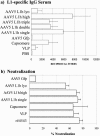Intranasal vaccination with recombinant adeno-associated virus type 5 against human papillomavirus type 16 L1
- PMID: 16501072
- PMCID: PMC1395428
- DOI: 10.1128/JVI.80.6.2621-2630.2006
Intranasal vaccination with recombinant adeno-associated virus type 5 against human papillomavirus type 16 L1
Abstract
Adeno-associated viruses (AAV) have been developed and evaluated as recombinant vectors for gene therapy in many preclinical studies, as well as in clinical trials. However, only a few approaches have used recombinant AAV (rAAV) to deliver vaccine antigens. We generated an rAAV encoding the major capsid protein L1 (L1h) from the human papillomavirus type 16 (HPV16), aiming to develop a prophylactic vaccine against HPV16 infections, which are the major cause of cervical cancer in women worldwide. A single dose of rAAV5 L1h administered intranasally was sufficient to induce high titers of L1-specific serum antibodies, as well as mucosal antibodies in vaginal washes. Seroconversion was maintained for at least 1 year. In addition, a cellular immune response was still detectable 60 weeks after immunization. Furthermore, lyophilized rAAV5 L1h successfully evoked a systemic and mucosal immune response in mice. These data clearly show the efficacy of a single-dose intranasal immunization against HPV16 based on the recombinant rAAV5L1h vector without the need of an adjuvant.
Figures






Similar articles
-
Combined prophylactic and therapeutic intranasal vaccination against human papillomavirus type-16 using different adeno-associated virus serotype vectors.Antivir Ther. 2009;14(8):1125-37. doi: 10.3851/IMP1469. Antivir Ther. 2009. PMID: 20032542
-
Intranasal vaccination with AAV5 and 9 vectors against human papillomavirus type 16 in rhesus macaques.Hum Gene Ther. 2012 Jul;23(7):733-41. doi: 10.1089/hum.2011.202. Epub 2012 Apr 18. Hum Gene Ther. 2012. PMID: 22401308 Free PMC article.
-
Co-vaccination with adeno-associated virus vectors encoding human papillomavirus 16 L1 proteins and adenovirus encoding murine GM-CSF can elicit strong and prolonged neutralizing antibody.Int J Cancer. 2005 Jan 1;113(1):93-100. doi: 10.1002/ijc.20530. Int J Cancer. 2005. PMID: 15386434
-
Chapter 12: Prophylactic HPV vaccines: underlying mechanisms.Vaccine. 2006 Aug 31;24 Suppl 3:S3/106-13. doi: 10.1016/j.vaccine.2006.05.110. Epub 2006 Jun 23. Vaccine. 2006. PMID: 16949996 Review.
-
Recent developments in human papillomavirus vaccines.Expert Opin Investig Drugs. 2004 Aug;13(8):959-71. doi: 10.1517/13543784.13.8.959. Expert Opin Investig Drugs. 2004. PMID: 15268634 Review.
Cited by
-
Bioengineered Viral Platform for Intramuscular Passive Vaccine Delivery to Human Skeletal Muscle.Mol Ther Methods Clin Dev. 2018 Jul 24;10:144-155. doi: 10.1016/j.omtm.2018.06.001. eCollection 2018 Sep 21. Mol Ther Methods Clin Dev. 2018. PMID: 30101152 Free PMC article.
-
Vesicular transport of progeny parvovirus particles through ER and Golgi regulates maturation and cytolysis.PLoS Pathog. 2013 Sep;9(9):e1003605. doi: 10.1371/journal.ppat.1003605. Epub 2013 Sep 19. PLoS Pathog. 2013. PMID: 24068925 Free PMC article.
-
Targeting HIV-1 conserved regions: An immunoinformatic pathway to vaccine innovation for the Asia.PLoS One. 2025 Mar 21;20(3):e0317382. doi: 10.1371/journal.pone.0317382. eCollection 2025. PLoS One. 2025. PMID: 40117271 Free PMC article.
-
Intranasal immunization with synthetic peptides corresponding to the E6 and E7 oncoproteins of human papillomavirus type 16 induces systemic and mucosal cellular immune responses and tumor protection.Vaccine. 2007 Apr 30;25(17):3302-10. doi: 10.1016/j.vaccine.2007.01.010. Epub 2007 Jan 24. Vaccine. 2007. PMID: 17291642 Free PMC article.
-
A new genetic vaccine platform based on an adeno-associated virus isolated from a rhesus macaque.J Virol. 2009 Dec;83(24):12738-50. doi: 10.1128/JVI.01441-09. Epub 2009 Oct 7. J Virol. 2009. PMID: 19812149 Free PMC article.
References
-
- Balmelli, C., S. Demotz, H. Acha-Orbea, P. De Grandi, and D. Nardelli-Haefliger. 2002. Trachea, lung, and tracheobronchial lymph nodes are the major sites where antigen-presenting cells are detected after nasal vaccination of mice with human papillomavirus type 16 virus-like particles. J. Virol. 76:12596-12602. - PMC - PubMed
Publication types
MeSH terms
Substances
LinkOut - more resources
Full Text Sources
Other Literature Sources

